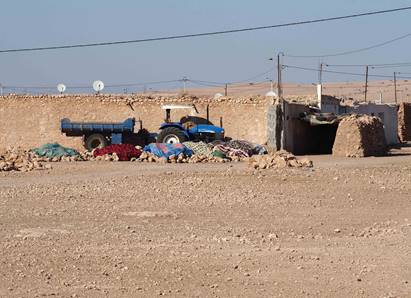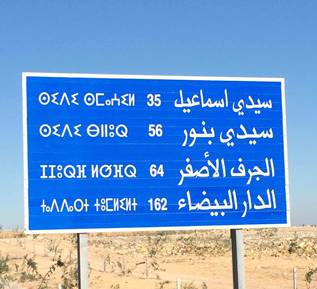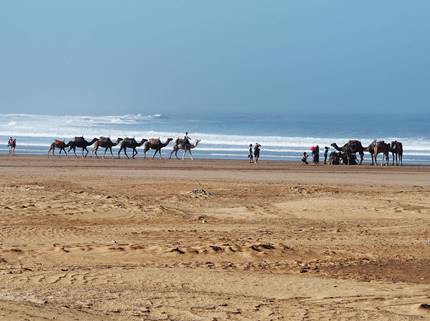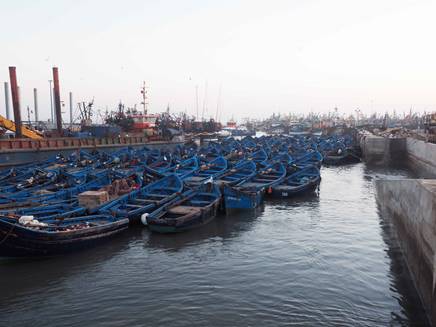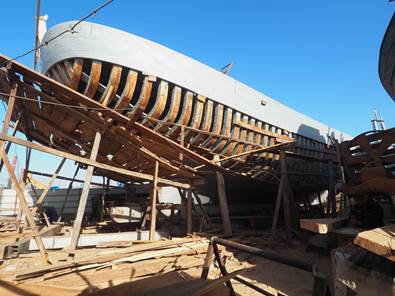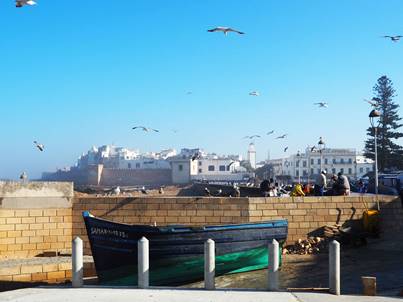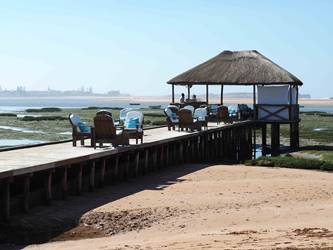24 Oct - Moroccan Coastal Caravanserais

|
34: 01.7N 006:49.3W
Moroccan roadside life: a rare Massey Ferguson and typical Stone Age dwelling. Satellite dishes indicate humans as well as goats live here… As we drove towards the coast, we wondered about Marrakech. Why did we not like it as much as we had expected? It has all the ingredients: a long history as a crossroads in the heart of north Africa; the home of an empire that stretched to Barcelona and beyond. Friendly people, a pleasant climate (certainly in October), beautiful architecture, romance, exotic sights, sounds and smells… Perhaps it’s a victim of its own success? Perhaps the rise of the budget airline destination has fuelled the combination of cash-rich tourist and ambitious local lad to create a monster which is accelerating out of control? We may have been unlucky on Saturday night in the heart of Marrakech; Sunday certainly restored our faith in the myth… but enough to want to rush back? Probably not.
Straight on? This roadsign is in Berber and Arabic scripts. It’s not just the Welsh who insist on dual language signs! The road to Essaouira is unbelievably straight. So straight that I got caught by one of the multitude of traffic cops lining the route as I was doing 70kph in a 60kph zone. He was awfully nice about it and the 300 dirham fine became 200 dirhams in cash, but I left without a single form being filled in and wondered where the money went? It doesn’t go on the sides of the roads, which are gradually narrowing as scores of heavy lorries break down the verges and the new roads gradually turn into narrow tracks. Still, it aids concentration! Our hotel in Essaouira was the famous ‘L’Heure Bleue’ just inside the walls of the old medina. The blue door would have been hard to spot if I did not know to look for it, but inside is an oasis of 19th century Moorish/Spanish/French Colonial bliss. High arched ceilings, pot plants four storeys high, tiny water features, beautiful tiles, attentive but unobtrusive staff proffering beautiful fresh dates and more mint tea. It’s a big building with a wonderful rooftop garden and swimming pool overlooking the old town, the harbour and the beaches, but with a 30 knot breeze blowing we decided to forego the sunbathing and explore the town before dark. We located our restaurant – an interesting mix of French Colonial and traditional Moroccan – and examined the magnificant sea walls. Essaouira is an ancient fishing port, pirate hideout, African trading and slaving centre and now the home of Bohemian artists, hippies, windsurfing and kite surfing in Morocco. It has all the exoticism of Marrakech, without the bedlam. The port is extraordinary: wall to wall boats, either small blue open boats, or 100 foot wooden trawlers. And three glass fibre yachts! Two of them had British flags on and were boats we had seen in Rabat a couple of days earlier. I wondered if we had been a bit feeble coming here by car, when they had obviously taken the chance to sail here and got in safely. But we doubted whether they could leave their boats unattended – so on balance, leaving Escapade in a secure, dull marina in Rabat and having this unique North African road trip without having to worry about the boat was the right thing to do.
The beach at Essaouira In the morning, we returned to the fishing port to take photographs and soak up the atmosphere. Many of the bigger boats had sailed, but the place was buzzing – and humming too. I like the smell of fish and having served in Fishery Protection, can cope with the stench of rotting fish too. Here, it was mixed with raw sewage, diesel and Heaven knows what… We were befriended by a security guard chap who showed us around a big fishing trawler under construction. Built from African Iroko, it was immensely strong and rather beautiful. Apparently it was destined for a French port for €800,000.
The fishing fleet at Essaouira
Note the three yacht masts in the middle…
My next command?
More likely! The walled town of Essaouira behind. On our way back to the hotel, we bought Argan Oil from a women’s cooperative. I wondered if they knew of the ladies lunching in Rabat? The oil comes from the Argan Tree and is being marketed as an alternative to olive oil. It’s been around for centuries, but the Argan nut is quite hard, so the traditional means of harvesting involves feeding it to goats and then sorting through the by-products. Julie was assured that modern techniques have cut out the middle-goat and the oil looks beautiful. It smells slightly nutty, but nothing like the fishing port and we now have a bottle in the galley, so will report on its culinary utility in due course. Look out for it in Harrods!
Making Argan Oil After Essaouira, we headed north along the coast towards Rabat. It’s four hundred miles, so we could not stop for long! The road was winding, with great views down over the dunes and along the coast. Great rolling Atlantic surf, Argan trees everywhere (suddenly!), much more livestock in the fields and a Mediterranean feel to the place. The bigger towns of Safi and Al Jadida are focused on phosphate mining and export, so not that glamorous. But we had secret intelligence from Julie’s sister Susan on a good place to stop for lunch – Oualidia – where we found a hotel called the Sultana. Our aged Satnav had never heard of it, so we relied on old-fashioned map reading using a Michelin map of North Africa. At El Jadida, we found ourselves pushed onto a brand new motorway (only Westerners can afford the tolls) and were starting to think we would not find it, when a roadsign to ‘Loualyida’ offered a possible solution. Ten miles along a single-track road across an impossible moonscape, we emerged on the top of a cliff overlooking a wonderful lagoon below and the town of Oualidia at our feet. A true oasis, but nestling against the sand dunes of the North Atlantic. We found the hotel almost by accident. It probably offers one of the most luxurious, pampered retreats anywhere. We were a bit unlucky with the food – the ‘famous paella’ had probably peaked about an hour before and was a bit dry by the time it reached us – but the setting on the shores of a wonderful lagoon and with the Atlantic rollers in the background - was quite magical. I think I would like to return.
Oualidia
Luxury lunch setting… We stayed there a bit too long, so reached Casablanca in the middle of the rush hour. After twenty minutes sitting in a huge traffic jam, we abandoned our plan to visit the Grand Mosque and the replica Harry’s Bar, and pushed on back to Rabat. A long, but wonderful day and a really great road trip. Now for the Canaries!
|
